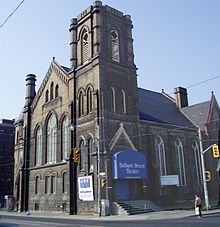
The Presbyterian Church of the Covenant, subsequently Avenue Road Presbyterian Church, the Avenue Road United Church and later Church of the Nazarene, was a church located on Avenue Road on the northeastern corner of Roxborough Avenue in Toronto, Ontario, Canada.

Knox College is a postgraduate theological college of the University of Toronto in Toronto, Ontario, Canada. It was founded in 1844 as part of a schism movement in the Church of Scotland following the Disruption of 1843. Knox is affiliated with the Presbyterian Church in Canada and confers doctoral degrees as a member school of the Toronto School of Theology.
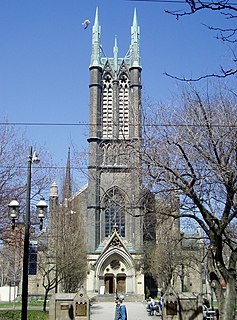
Metropolitan United Church is a historic Neo-Gothic style church in downtown Toronto, Ontario, Canada. It is one of the largest and most prominent churches of the United Church of Canada. It is located at 56 Queen Street East, between Bond and Church streets, in Toronto's Garden District.

College Street United Church is a United Church of Canada church at the corner of College and Bathurst Streets in Toronto, Ontario, Canada. As of 1990 the church is part of the same structure as The Channel Club Condo at 456 College Street.

St. Andrew's Church is a large and historic Romanesque Revival Presbyterian church in downtown Toronto, Ontario, Canada.
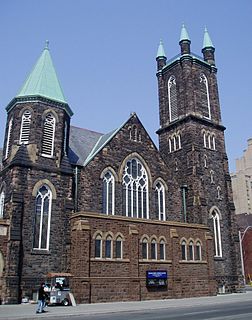
Bloor Street United Church is a United Church of Canada church in Toronto, Ontario, Canada. It is located downtown near the intersection with Huron Street. It is just north of the University of Toronto, and between the Spadina and St. George subway stations.

Knox Presbyterian Church is a Presbyterian church in downtown Toronto, Ontario, Canada.
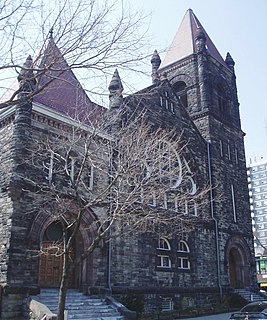
Trinity-St. Paul's United Church and Centre for Faith, Justice and the Arts is a church belonging to the United Church of Canada in Toronto, Ontario, Canada. It is located at 427 Bloor Street West, just west of Spadina Avenue in the city's downtown core. The church is formed of a mix of three different former congregations and houses a fourth independent congregation within its building.

St. Paul's-Avenue Road United Church was a church in downtown Toronto. It was founded in the 1870s. St. Paul's Methodist Church and its home on Avenue Road just north of Bloor Street in the Yorkville community, was built in 1877. With church union in 1925, it became St. Paul's United and in 1930 it merged with the nearby Avenue Road and became St. Paul's-Avenue Road United.
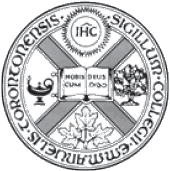
Emmanuel College is a theological college of Victoria University at the University of Toronto. Affiliated with the United Church of Canada, it is a member institution of the Toronto School of Theology. The current principal is Michelle Voss Roberts. Emmanuel College is a member of the Association of Theological Schools in the United States and Canada.

Deer Park United Church is the name of a United Church of Canada congregation, and also the name of this congregation's former church building at 129 St. Clair Avenue West in the Deer Park area of Toronto, Ontario, Canada. It was one of two United Church of Canada buildings in the area and along St. Clair Avenue, the other being Timothy Eaton Memorial Church.

Calvin Presbyterian Church is a Presbyterian Church in Canada congregation in the Deer Park area of Toronto, Ontario, Canada. The church building is located at 26 Delisle Avenue, close to Yonge Street and St. Clair Avenue.
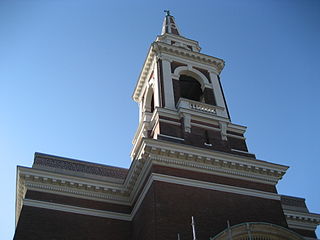
Central Presbyterian Church is a Presbyterian Church in Canada congregation in Hamilton, Ontario, Canada, located in the downtown area at the corner of Charlton and Caroline Street South.

Central United Church is a historic congregation of the United Church of Canada located in the community of Weston, now a neighbourhood of Toronto, Ontario, Canada. Founded in 1821, the church has occupied the same site on Weston Road in Toronto since then.

Wesley Mimico United Church is a church in Toronto, Ontario, Canada. It is located in the neighbourhood of Mimico in the former city of Etobicoke. The church was created by the union of the former Wesley Methodist Church, Mimico and St. Paul's Presbyterian Church in 1927, of which the Methodist church was the larger partner.
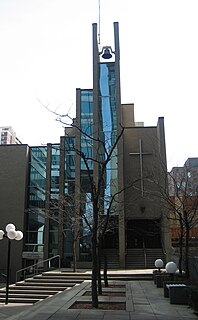
St. Andrew's United Church is an historic congregation of the United Church of Canada in Toronto, Ontario, Canada. Located in the city's downtown core near the intersection of Yonge and Bloor it is a combination of five other downtown Toronto congregations. The church originated from St. Andrew's Church, founded in 1830 as the first Church of Scotland congregation in what was then the town of York. The original St. Andrew's was located at the corner of Adelaide and Church Streets. By the 1870s it had become clear that a new church was needed. The downtown core had moved westward, and most of the congregation wanted to shift in that direction as well, but a minority staunchly opposed the idea. With the congregation thus split, the majority moved to a new structure at King and Simcoe in 1876 that still exists today as St. Andrew's Church.

Asbury & West United Church is a United Church of Canada church in the Bathurst and Lawrence area of Toronto, Ontario, Canada. The congregation has one of the longest continual histories of any in Toronto. It traces its history back to 1812 and meetings of small groups of Methodist settlers in what was an area being newly settled by Europeans. The first services were held in the farmhouse of Henry Mulholland, a veteran of the War of 1812 and the Battle of Lundy's Lane. He first came to Canada from Ireland in 1806, settling in the area that would later be named Henry Farm after him. He later moved further west to what is now the Bathurst and Lawrence area.

Broadway Methodist Tabernacle was a prominent Methodist church in Toronto, Ontario, Canada, that existed from 1872 to 1924. The congregation was originally housed in a wood chapel at the intersection of Spadina Avenue and Dundas Street, which at that time was known as St. Patrick Street. It was originally named the Spadina Avenue Methodist Church. Rapid growth in the congregation saw it seek a new home, and in 1876 a larger lot was purchased at the northeast corner of Spadina and College Street. The wooden church was transported on rollers north to the new location. The old site eventually became the location of the Standard Theatre.

The Randolph College for the Performing Arts is a private career college specializing in singing, dancing and acting. It was founded on September 8, 1992, by George C. Randolph Jr. It is located in Toronto, Ontario, on the southwest corner of Lennox Street and Bathurst streets, just south of the former Honest Ed's. The building that was formerly the Bathurst Street Theatre houses the school.

Wesley Uniting Church is a heritage-listed former church at 54 Neil Street, Toowoomba, Toowoomba Region, Queensland, Australia. It was designed by Willoughby Powell and built from 1877 to 1924. It is also known as Wesleyan Methodist Church. It was added to the Queensland Heritage Register on 10 May 1997.
